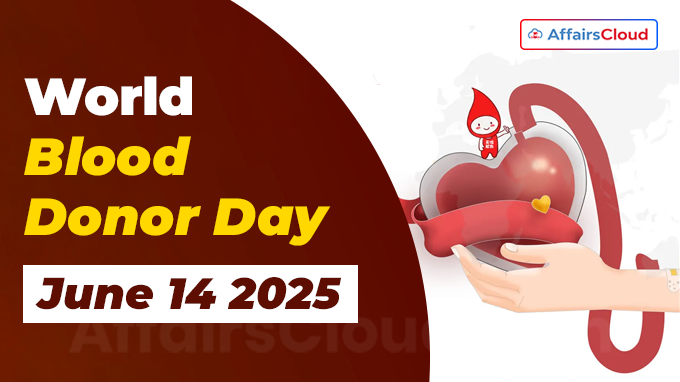 World Blood Donor Day (WBDD) is observed annually on June 14 worldwide to recognize the contributions of voluntary, unpaid blood donors and raise awareness about the critical need for safe blood and blood products.
World Blood Donor Day (WBDD) is observed annually on June 14 worldwide to recognize the contributions of voluntary, unpaid blood donors and raise awareness about the critical need for safe blood and blood products.
- June 14, 2025, marks the 21st anniversary of WBDD, observed under the World Health Organization’s (WHO) leadership.
- Italy hosts the 2025 global events through its Rome (Italy)-based National Blood Centre (Centro Nazionale Sangue, CNS).
2025 Theme:
The theme of WBDD 2025, “Give blood, give hope: together we save lives,” emphasizes the collective strength and life-saving impact of voluntary blood donations.
Objectives of WBDD 2025:
i.Raise public awareness about the need for blood and plasma donations and their life-saving impact.
ii.Encourage new and existing donors to donate regularly.
iii.Promote values of solidarity, compassion, and community.
iv.Mobilize governments to invest in national blood programs for universal access to safe blood.
Background:
i.WBDD was established in 2004 by WHO to commemorate the birth anniversary of Karl Landsteiner (1868–1943), the Austrian-American biologist and physician who discovered the ABO blood group system in 1901.
ii.The first WBDD was observed on June 14, 2004, and was jointly organised by WHO, the International Federation of Red Cross and Red Crescent Societies (IFRC), the International Federation of Blood Donor Organizations (IFBDO), and the International Society of Blood Transfusion (ISBT).
iii.In 2005, the 58th World Health Assembly (WHA) adopted resolution WHA58.13, titled “Blood safety: proposal to establish World Blood Donor Day,” which officially designated 14 June as the annual observance of WBDD.
About Karl Landsteiner:
i.Karl Landsteiner, born on 14 June 1868 in Vienna, Austrian Empire (present-day Austria), is widely regarded as the “founder of modern blood transfusion.”
ii.He was awarded the Nobel Prize in Physiology or Medicine in 1930 for his groundbreaking discovery of human blood groups, which made safe blood transfusions possible.
iii.He passed away on 26 June 1943 in New York, United States of America(USA).
About Global Database on Blood Safety (GDBS):
i.The WHO established the GDBS in 1998 to collect and analyze data from its Member States regarding blood and blood product safety.
ii.Data are gathered through standardized questionnaires sent annually to national health authorities, initially covering 1998–99, followed by periodic updates (e.g., 2001–02, 2004–05, 2016, and 2021) .
Critical Global Statistics:
i.Maternal Health: Nearly 800 women die daily from pregnancy-related bleeding; Sub-Saharan Africa records the highest maternal mortality (510 deaths per 100,000 live births)
ii.Donation Disparities:
- 40% of global blood donations (118.5 million) occur in high-income countries (16% of the world’s population).
- 54 countries rely on paid or family donors for more than 50% of the blood supply.
- 40 countries in Africa collect less than 10 blood donations per 1,000 people annually.
- India’s South-East Asia Region (SEAR) reported around 22.3 million whole blood donations, all screened for Transfusion-Transmitted Infections (TTIs) and ABO group, serving as a model of progress in blood safety standards.
2025 Events:
On the occasion of WBDD 2025, the National Film Development Corporation (NFDC) under the Ministry of Information & Broadcasting (MIB), Government of India (GoI), partnered with Mumbai (Maharashtra) based Kamala Ankibai Ghamandiram Gowani Trust (Kamala Trust) and Karjat (Maharashtra) based Raigad Hospital Blood Centre to organise a blood donation drive at the NFDC premises in Mumbai.
- Over 50 NFDC employees, along with several external participants, actively took part by pledging and donating blood during the drive.
About International Federation of Red Cross and Red Crescent Societies (IFRC):
IFRC is the world’s largest humanitarian network, made up of 191 National Societies. It works to save lives, support local communities, promote dignity, and build resilience worldwide.
President – Kate Forbes
Headquarters – Geneva, Switzerland
Formed – 1919



